There are many dental treatments today to accommodate everyone. There are short-term, long-term, expensive, inexpensive, invasive, less-invasive, minimally invasive, non-invasive, and on and on. Although having many choices is great, it can also be overwhelming. What is the right dental treatment for you? Which ones fit into your budget and time-constraints? Should you opt for a short-term treatment or long-term fix? Today we discuss dental bonding, a minimally invasive, affordable, quick, and easy dental treatment that can be used to treat a variety of dental imperfections. Get your questions answered with our dental bonding FAQs.
FAQs
Q: What is dental bonding?
A: Dental bonding, also referred to as cosmetic bonding, consists of adding a composite resin material to your teeth to treat dental imperfections. The material is a plastic and glass mixture, available in various shades of white to blend with the natural color of your surrounding dentition. It is very strong and can last up to 10 years or more.
Q: What dental imperfections can bonding repair?
A: Bonding can be used to treat a variety of problems such as chips, cracks, fractures; tooth stains and discoloration; it can be used to lengthen worn down teeth; change the shape of teeth; fill gaps or spaces between teeth; and more.
Q: What should I expect during treatment?
A: Bonding is quick, easy, and painless. To prepare the tooth your dentist will clean it first, then apply an “etching” gel to roughen the surface for a better bond. Next, the resin material is either painted on as a liquid, or applied in a putty-like state and shaped and sculpted. It is hardened using a special curing light and then polished to achieve a pleasant shine.










